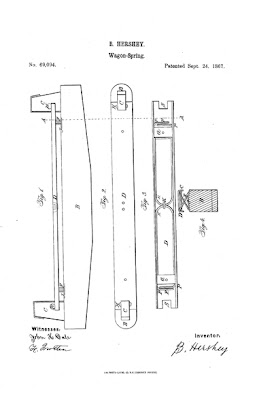To that point, over the years, questions have persisted as to how certin types of wagons and equipment were used. One of the more often-asked queries we’ve received is whether period chuck wagons were ever equipped with bolster springs. Recognizing that bolster spring patents were granted as early as the 1860’s, it’s clear that the technology was certainly available during the post Civil War timeframe of the great cattle drives (1865-1885). But, did anyone put this equipment on an early chuck wagon used in the West? Part of the challenge in answering this question comes from so much written history being lost over time. Equally frustrating is the serious shortage of original imagery available from that historical genre.
As we mentioned last week, the photo we’re analyzing does show a wagon with at least a forward-mounted pantry and quite likely (due to other evidence in the image), a rear positioned chuck box as well. Assigning a date to a particular 19th century image is not always possible but, with a little detective work, the era can often be narrowed down.
The image we presented last week could not have been taken prior to the Civil War. That is easily known due to the establishment date of the company that originally published the photo. We also know the image location is somewhere in Colorado due to the printed information on the photo mount. To further assess our own evaluation of the archive image, we contacted two experts in 19th century clothing and frontier equipage.
Thomas Lindmier spent years as the curator of the Ft. Laramie and Ft. Bridger museums as well as managing numerous other Wyoming State Park and Historic Sites including the Wyoming Territorial Prison. As the author of multiple books including, “I See By Your Outfit” and “The Great Blue Army Wagons,” Mr. Lindmier has a tremendous amount of experience analyzing just such mysteries as the date of our photo.
Likewise, with a Master’s Degree in textiles and historic clothing, Connie Lindmier’s credits include historical preservation and oversight work for numerous major museums such as The (Gene) Autry National Center of the American West in Los Angeles and the National Cowboy and Western Heritage Museum in Oklahoma City. Her expertise in early clothing has also been showcased in numerous major motion pictures including Ironclad, The Patriot, City Slickers and Dances with Wolves. Additionally, she has served as curator of the Laramie Plains museum and the Wyoming National Guard museum.
Each reviewed the photo separately and in detail that is often overlooked. Boot seams, heel positions, pant cuts, collar shapes, vest designs, coat patterns, hat styles, camp provisions and weaponry shown were all individually assessed. Their conclusion? The image will date to the late 1860’s or early 1870’s.
This evaluation is a direct match to our original conviction that the image easily fits a circa 1870 definition. Equally significant, to our knowledge, this rare photograph is the earliest known depiction of a western chuck wagon fitted with bolster springs. How many actual trail wagons – if any – used this technology? It’s a question that has yet to be fully explored and may never be sufficiently answerable due to the overall lack of surviving primary source materials. That said, with this follow-up photo analysis, we are able to conclude that at least some chuck wagons used during the time of the great cattle drives made use of bolster springs. These details add even more significance to Studebaker promotions from 1883 showing their “Round-Up” chuck wagons likewise outfitted with bolster springs mounted above both the front and rear bolsters.

-copy.jpg)